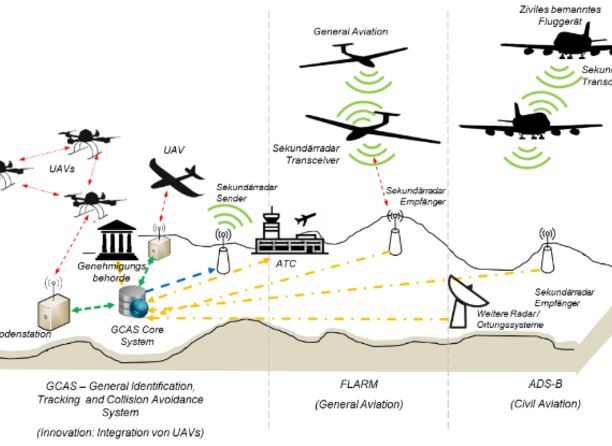GCAS - Security System for manned and unmanned aerial vehicles
Ref.-No. 3953
Keywords: Unmanned aerial vehicles (UAV), aerospace, aircraft, surveillance, drones
After drones or unmanned aerial vehicles (UAV) used to be used either as a toy earlier or reserved for the military, their use wins rapidly. UAVs are supposed to bring packages, measure the environment or take over monitoring tasks. The UAVs are getting bigger, more powerful and their numbers are rapidly increasing, as well as the danger of collisions with manned or unmanned aerial vehicles.
GCAS is a system that can avoid collisions between aircraft, whether manned or unmanned. For this purpose, the UAVs are clearly identified and provided with a machine-readable label. The position data of one UAV can then be forwarded to neighboring UAVs. Since a UAV usually also has components on the ground that are in constant contact with the aircraft, the ground station always has the relevant flight data of the UAV. These can then be quickly transferred to other systems such. B: FLARM or ADS-B are passed. At the same time, this can automate the keeping of a logbook.
Competitive Advantages
- Cross- system collision avoidance
- Predictive flight planning
- Spreading informations to other aircrafts and UAVs
Commercial Opportunities
With the aid of the invention it is possible to avoid collisions between UAVs and manned aircraft in any combination. Thus, the system enables a safe, daily use of UAVs in civil airspace. Possible application areas include geoinformation, inspection of power transmission lines, wind turbines, oil rigs, logistics applications and many other areas.
Current Status
Patents in FR, DE, GB, and US have already been granted and a European patent application has been filed. The procedure has been verified experimentally. On behalf of the TU Dortmund, we offer interested companies the opportunity to license and further develop the technology.
Technology Readiness Level
1
2
3
4
5
6
7
8
9
Technology validated in lab
—
An Invention of TU Dortmund.



